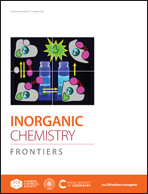In situ determination of the interplay of the structure and domain under a subcoercive field in BiScO3–PbTiO3†
Abstract
The extraordinary performances of phase-coexisting ferroelectrics are significantly affected by not only the phase constitution but also the motion of domain walls. The study on the role of phase coexistence in the formation of ferroelectric and ferroelastic domain microstructures is of great importance to explain the enhanced piezoelectric properties. In situ high-energy diffraction and the Rayleigh law are utilized to reveal the interplay of phase constitution and domain configuration to the macroscopic electromechanical coupling effect in the morphotropic phase boundary composition of 0.365BiScO3–0.635PbTiO3 during the application of a weak electrical loading in the present study. It was found that anisotropic phase transition and domain switching occur in polycrystalline ferroelectric ceramics and a phase transition occurs dramatically beyond the coercive field. Taking into account the important role of coupled ferroelectric and ferroelastic domain microstructures, we conceived a configuration of monoclinic domains coexisting with and bridging the tetragonal domains. The existence of bridging domains would provide an insight into the interplay of the phase and domain and explains the piezoelectric performance in the vicinity of morphotropic phase boundaries.



 Please wait while we load your content...
Please wait while we load your content...
